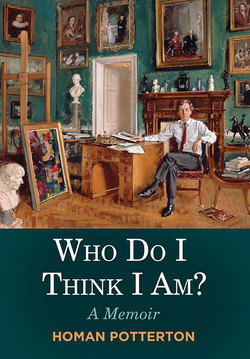Читать книгу Who Do I Think I Am? - Homan Potterton - Страница 7
На сайте Литреса книга снята с продажи.
ОглавлениеPrologue
‘The National Gallery Restaurant’ by Paul Durcan
One of the snags about the National Gallery Restaurant
Is that in order to gain access to it
One has to pass through the National Gallery.
I don’t mind saying that at half past twelve in the day,
In my handmade pigskin brogues and my pinstripe double-vent,
I don’t feel like being looked at by persons in pictures
Or, worse, having to wax eloquent to a client’s wife
About why it is that St Joseph is a black man
In Poussin’s picture of ‘the Holy Family’:
The historical fact is that St Joseph was a white man.
I’d prefer to converse about her BMW – or my BMW –
Or the pros and cons of open-plan in office-block architecture.
I clench the handle of my briefcase
Wishing to Jesus Christ that I could strangle Homan Potterton–
The new young dynamic whizz-kid Director.
Oh but he’s a flash in the pan –
Otherwise he’d have the savvy to close the National Gallery
When the National Gallery Restaurant is open.
Who does Homan Potterton think he is – Homan Potterton?
From The Berlin Wall Cafe by Paul Durcan published by Harvill Press. Reproduced by permission of The Random House Group Ltd. ©1995.
The poet Paul Durcan published this poem first in Image magazine and when I read it (having, to my shame, never heard of Paul) I was not very impressed. I was engaged at the time in trying to close, not the National Gallery, but the National Gallery restaurant. It, and its menus, dated from 1968 and very few of the people who lunched there – arriving in their BMWs and discussing office-block architecture – had the slightest interest in Poussin or indeed any other artist represented in the gallery. As to why St Joseph is a black man in Poussin’s Holy Family, I had had very little time to consider such iconographical complexities since becoming director of the gallery a year or so previously.
But I was new, and I was young, and I am flattered that Paul described me as a ‘dynamic whizz-kid’. But was I a ‘flash in the pan’?
Yes, I am afraid I was. Paul was right. Many people thought it unseemly when I resigned after only eight years in office.
Mine was not the shortest-lived directorship: several of my predecessors – Hugh Lane among them1– served for an even shorter period. But, appointed in December 1979 at the age of thirty-three, I was the youngest.
The road I had taken from a childhood in County Meath and schooldays in Kilkenny and Dublin to the director’s office in Merrion Square had, in retrospect, been quite straightforward and what one might expect of any museum director: I studied art history at university and then studied more of it at another university, got a job in a museum or two, published some art-historical articles and books, and before I knew it, I was a director.
I did, however, make a few detours and stops as I travelled – quite unintentionally, at some speed – along this route. Some people engaged my attention; particular events caused me to linger; certain places appealed to me more than others. It was those detours and stops – rather than my progress – which rendered my journey enjoyable and (to me) memorable.
As to what I found when I reached my destination, much of that was enjoyable – and certainly memorable – too, although some of it was not. But I had arrived far too soon; my journey had been too short.
And that, I think, was what made me just ‘a flash in the pan’.
As to who I thought I was, the following pages may tell.
Endnotes
1.Lane was appointed in March 1914 and drowned from the Lusitania fourteen months later on 7 May 1915.
